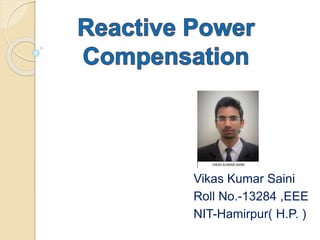
Reactive power compensation
- 1. Vikas Kumar Saini Roll No.-13284 ,EEE NIT-Hamirpur( H.P. )
- 2. Contents :- Introduction Power triangle Reactive power Why do we need reactive power Need for reactive power compensation Compensation techniques Conclusion
- 3. Introduction : - The demand of the reactive power is mainly originated from inductive load connected to the system . These inductive loads generally electromagnetic circuit of electric motors, electrical transformers, distribution networks and induction furnaces etc. Reactive power compensation is the defined as the management of reactive power to improve the performance of AC system . There are two aspects : - 1. Load compensation 2. Voltage support
- 4. Power Triangle : - Active Power ( P ) Reactive Power ( Q ) Apparent Power ( S )
- 5. Active Power ( P ) : - It is the power that actually powers the equipment and performs useful work . Unit of it W . Reactive Power ( Q ) : - It is the power that magnetic equipment { transformer , motor etc. } needs to produce the magnetizing flux . Unit of it VAr . Apparent Power ( S ) : - It is the “ vectorial summation ” of active power ( P ) and reactive power ( Q ) . Unit of it VA .
- 6. Reactive Power : - The portion of power flow that is temporarily stored in the form of magnetic or electric fields , due to inductive or capacitive network element and then returned to source is known as reactive power . Reactive power can best be described as the quantity of “unused” power that is stored in reactive components , such as inductors or capacitors . In other words , the reactive circuit returns as much power to the supply as it consumes .
- 7. Why do we need reactive power : - In resistive loads the current produces the heat energy which produces the desired output but incase of inductive loads the current creates the magnetic field which further produces the desired work. Therefore reactive power is the non working power caused by the magnetic current to operate and sustain magnetism in the device . Reactive power (vars) is required to maintain the voltage to deliver active power (watts) through transmission lines. When there is not enough reactive power the voltage sags down and it is not possible to deliver the required power to load through the lines.
- 8. Need for reactive power compensation : - Reactive power generated by the ac power source is stored in a reactor during a quarter of a cycle and in the next quarter of the cycle it is sent back to the power source. Therefore the reactive power oscillates between the ac source and the reactor at a frequency equals to two times the rated value (50 or 60 Hz). So to avoid the circulation between the load and source it needs to be compensated . To improve system power factor .
- 9. Reduce losses associated with the system . Improves the voltage regulation in the network . Increased system stability . Reactive power levels have an effect on voltage collapse .
- 10. Compensation : -
- 11. Compensation Techniques : - Synchronous Condenser Shunt Compensation Series Compensation
- 12. Synchronous Condenser : - Synchronous condensers are the active shunt compensators and have been used to improve the voltage profile and system stability . It is installed at the receiving end of the line . When machine is overexcited , it acts as shunt capacitor as it supplies VAr to the system and when under excited it acts as a shunt coil as it absorbs reactive power to maintain terminal voltage.
- 13. Shunt Compensation : - The device that is connected in parallel with the transmission line for reactive power compensation is called the shunt compensator It can be provided by either a current source, voltage source or a capacitor. If XC = 1/ωC be the reactance of the shunt capacitor then the reactive power generated of leading VAr supplied by the capacitor: Where, |V2| is the magnitude of receiving end voltage. CV X V Q C C 2 2 2 2
- 14. Transmission line with shunt compensation : -
- 15. Series Compensation : - Capacitor are connected in series in the lines and are used mainly for boosting the receiving end voltage, increase in transmission capacity and reduction in losses in the lines . The capacitive reactance of series capacitor neutralizes the inductive reactance of the line hence , reduces effective reactance of the line. Thereby , voltage regulation of the system is improved .
- 16. Transmission line with series compensation : -
- 17. Conclusion : - From all the previous discussion we can conclude that reactive power compensation is a must for improving the performance of the ac system. By reactive power compensation we can control the power factor and reduce the consumption of electricity .
- 18. References : - Need for reactive power compensation by ABB www.electrical-engineering portal.com www.electrical4u.com www.slideshare.net ethesis.nitrkl.ac.in/2243/1/Project_Thesis_Final.pdf